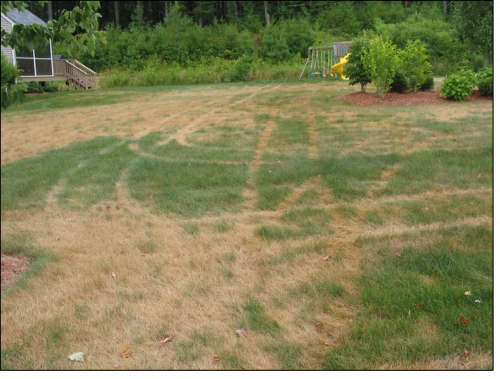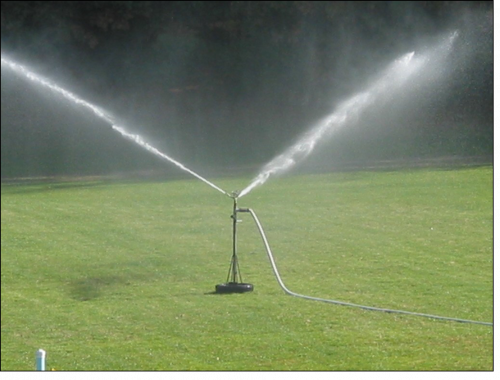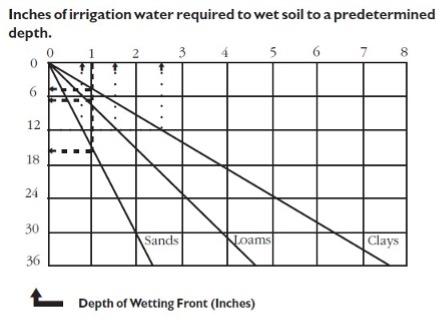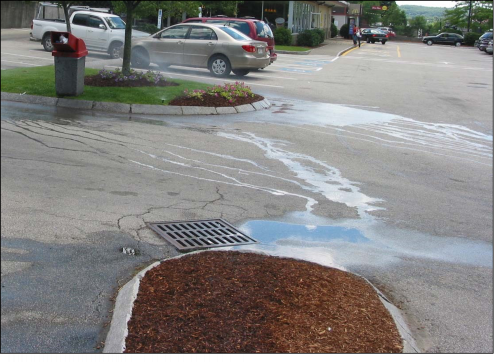OBJECTIVE: Reduce water use for turf management to the lowest possible level, to conserve and protect our most precious natural resource.
Implement water conservation strategies on the basis of both responsibility, and cost savings.
- The demand for potable water (drinking water) for agricultural, residential, and industrial use is expected to increase in the future while our supply of water will remain essentially unchanged.
- When rainfall is insufficient and water resources become limited, supplemental irrigation required to sustain plantings such as lawn and landscape turf is often the first to be placed on water use restrictions. Be sure to comply with local and state water use regulations and restrictions.
- Increased costs accompany tightening water availability; minimizing water use can enable greater budgetary efficiency.
Understand that replacement of turf areas with tree and shrub plantings won't necessarily conserve water.
- The use of trees, shrubs and other ornamental plantings in the landscape in lieu of turf does not necessarily suggest low water use or minimal maintenance.
- In studies that are available, which compare water use or evapotranspiration (ET), trees and shrubs have been regularly found to be higher water users than turfgrass.
Example: on average, research has demonstrated that one mature oak tree can have water requirements equivalent to 1800 ft2 of turf. This in large part is due to the greater leaf canopy surface area that is exposed to atmospheric (evaporative) demand.
- Adjacent trees and shrubs in the landscape commonly benefit from irrigation that may be applied to turf areas.
Be familiar with the concept of evapotranspiration (ET).
- Evapotranspiration is the sum total of water lost to the atmosphere due to evaporation from the soil surface plus transpirational water loss associated with leaf surfaces.
- In high density turf where 95% of the soil surface may be shaded by leafy vegetation, the major contributor to ET is transpiration.
- ET increases with increasing solar radiation, high temperatures, wind, and decreasing relative humidity.
Select turfgrass species and cultivars with demonstrated water use efficiency when possible and appropriate.
- Many modern turfgrass varieties have been developed to provide acceptable function and quality with reduced water input.
- By selecting turfgrass species (and cultivars) that have scientifically documented low water requirements or superior drought resistance, the turfgrass practitioner can delay or postpone drought stress injury and associated decline in turfgrass quality and function during extended periods of little or no water.
- Turfgrass species and cultivars with low leaf area (slow growth rates, narrow leaf width), high leaf and shoot densities, and horizontal leaf orientation use less water. Kentucky bluegrass varieties can vary by as much as 30% in their ET rate due to these plant (morphological) factors.
- Note that low water use does not necessarily equate to superior drought resistance because rooting depth is also an important drought resistance component.
OBJECTIVE: Carry out management practices with responsible water use as a priority.
Minimize supplemental irrigation to the lowest level required for the desired degree of turf performance.
- Irrigation should be applied at the onset of mild drought stress to recharge the root zone, unless dormancy is allowable on the site.
- Incorporate hand watering into the management program when appropriate.
- Irrigation should be timed in order to minimize duration of leaf wetness so as to reduce the incidence of diseases.
- Test water for irrigation suitability. Water department or board of health test results can often be accessed for this information.
- Maintain and adjust irrigation systems according to weather conditions.
- Supply adequate water for establishment, renovation, repairs, and overseeding.
Follow the ‘⅓ Rule’ when scheduling mowing events.
- Regular and frequent mowing helps to minimize water loss through reduced leaf area and turfgrass ET.
Maintain sharp mower blades.
- Dull mower blade injury can increase water use by delaying the healing of open wounds following mowing events. These wounds also promote disease infection.
Raise the height of cut (HOC) as summer progresses.
- Higher mowing heights promote deeper rooting and therefore access to greater amounts of soil water. This is especially true in spring when 60% of the total annual root mass is produced.
- Keep in mind that higher HOC can increase leaf area and hence ET losses during hot and dry conditions. Irrigated turf may be able to withstand lower HOC in summer than non-irrigated turf.
Apply fertilizer nitrogen at minimal levels timed to specific needs of turfgrass.
- Nitrogen (N) promotes leaf area (and ET) and reduces rooting depth, thus increasing the need to irrigate.
- For maximum water conservation, nitrogen, especially water soluble N, must be kept to the lowest possible level needed to sustain turf performance.
Apply potassium in balance with nitrogen.
- Potassium (K) is a nutrient that is important to turf during stress periods.
- Soil testing is needed to identify K deficiencies.
- If soil K levels are adequate based on a soil test, then K should be applied at levels that are approximately 25% to 50% of the total annual N.
- If soil K levels are inadequate based on a soil test, then K should be applied at levels that are approximately 50% to 75% of the total annual N.
- Higher K rates may be possible (and beneficial) on sandier soils or sand-based root zones.
Apply herbicides intelligently.
- Herbicides should be applied only as needed and according to label directions.
- Preemergence herbicides have a greater impact on roots than on shoots. Hence, turfgrass shoots may be unaffected while root activity is significantly reduced.
- Use split applications of soil-applied preemergence herbicides when appropriate to reduce the potential for adverse effects on turfgrass roots.
- Spot treat for broadleaf weeds, when possible, to limit stress; avoid blanket applications of herbicides when air temperatures exceed 85 °F.
Alleviate root-related stresses.
- Research has shown that deep rooting may play a more important role in water conservation and drought resistance than low ET.
- Factors that inhibit rooting can increase the need to water.
- Factors that inhibit rooting include acidic soil pH (< 5.5), excess thatch, inadequate depth of root zone, soil compaction, over-watering, excessively close mowing, excess N fertilization, and high soil temperature.
- Two or more root-inhibiting factors in combination can significantly reduce rooting depth more than any single factor when considered alone.
- Compaction and thatch are especially problematic because these conditions also promote runoff, which reduce irrigation efficiency and increase environmental impact.
Monitor and manage thatch accumulation.
- Manage thatch effectively. When levels exceed ⅓ to ½ inch (for lawn height turf), consider corrective action to promote deeper rooting into the soil and to limit rooting that is confined to the poor nutrient and water holding environment of the thatch.
Eliminate competition for plant available soil water.
- Remove all weeds that compete with turfgrass for limited plant available water.
- Design landscape plantings to minimize adverse interactions.
- Prune roots of trees near turf areas if possible to prevent tree roots from competing for nutrients and water.
Plan irrigation scheduling based on evapotranspiration (ET).
- This prevents over-watering (leaching and runoff losses) and under-watering (shallow rooting) of turf.
Example: On average, a Kentucky bluegrass turf will lose approximately 1.4 inches of water per week as ET during the irrigation season (July and August).
- Irrigation systems can be fitted with ET signaling controllers. Additional water savings of 20% are possible, as research has shown that acceptable turf quality can be maintained by replacing just 80% of water lost as ET.
Know your soil type.
- Sands hold approximately half as much plant available water as loam soils and soils high in clay, and therefore sands must be irrigated more often.
- Compacted soils and soils high in clay exhibit low soil infiltration rates, which promote surface water runoff.
- Irrigation systems can be fitted with features that permit multiple cycling so that irrigation (ET replacement) amounts are applied using short, repeated cycles. This multiple cycling increases water infiltration, minimizes runoff, reduces erosion risk erosion, and reduces waste.
- Heavier soils (loams, clays) and soils with a high percent of organic matter will retain water for a longer period than sandier soils.
Example: Using the chart above, one inch of water (indicated by the dashed line) applied to a clay soil would wet the soil to field capacity to a depth of approximately 5 inches; a loam to a depth of approximately 7 inches; and a sand to a depth of approximately 15 inches. Equivalently, to wet a soil to a depth of 12 inches (indicated by the dotted line) 0.75 inches of water is needed for sands; 1.5 inches of water for loams; and 2.5 inches of water for clays. Hence, it takes more than 3 times as much water to recharge a clay soil to field capacity to a 12-inch depth compared to sands as a result of the greater soil moisture-holding capacity associated with fine textured soils.
Eliminate waste.
- Irrigation systems that include rain-sensing override devices can eliminate unnecessary irrigation during rainfall events.
- Turf areas irrigated on narrow strips are difficult to water efficiently without wetting of non-grassy areas, and therefore should be avoided, or should have irrigation systems designed to apply water without waste.
- Irrigating during calm periods such as early morning can promote more uniform distribution of water and reduce evaporative and off-target losses.
- Clean up sidewalks and paved areas following maintenance operations by sweeping rather than by spraying with a hose.
- Correct areas of poor drainage to reduce pooling and ponding of water.
- Adjust systems to minimize irrigation that reaches impervious surfaces and repair all leaks as soon as detected.
Water deeply and infrequently.
- Water to fully recharge the plant available soil moisture pool and to insure that soil is wet to the maximum rooting depth. This is best achieved by irrigating according to ET.
- Rooting depth declines as summer progresses with increasing soil temperature. Inspect for proper soil wetting depth and rooting potential by soil sampling.
- Allow for mild drought stress (leaf roll/fold, foot printing) to occur between irrigation events to promote deeper rooting and drought resistance.
- Maintaining root zones at field capacity by over-watering will inhibit rooting, decrease drought resistance, and promote disease and soil compaction.
Maximize the amount of water that enters the root zone.
- Address conditions that reduce soil infiltration rates such as soil compaction, thatch, and hydrophobic soils.
- Under conditions associated with low infiltration the necessary amount of water should be applied using several short cycles or multiple irrigation events (referred to as multiple cycling), rather than applying all the water in one event.
- Irrigation should be scheduled when wind conditions are minimal in order to achieve a more uniform application.
OBJECTIVE: Manage for drought dormancy when the management program and user expectations allow.
 Take measures to ensure good recovery is possible when lawn areas are allowed to enter drought dormancy, especially when accompanied by high heat.
Take measures to ensure good recovery is possible when lawn areas are allowed to enter drought dormancy, especially when accompanied by high heat.
- Do not mow unless absolutely necessary.
- Strictly limit foot and vehicle traffic.
- Continue monitoring for pest infestation (chinch bugs, grubs, weeds). Manage damaging insect populations if needed.
- Do not fertilize dormant turf, as turf that is not actively growing cannot capture nutrients from the soil. Fertilize when cool weather and moisture return, and growth resumes.
- Plan to overseed any damaged areas that doo not recover sufficiently.
OBJECTIVE: Ensure that irrigation systems are properly designed, installed, and maintained.
Note: The following irrigation system BMPs are adapted with permission from BMPs for Turf and Landscape published by the Irrigation Association (IA). A detailed and complete version of the document including associated Practice Guidelines is available on the IA website at: http://www.irrigation.org/
Assure the overall quality of the irrigation system.
- The purpose of an irrigation system is to provide supplemental water when rainfall is not sufficient to maintain the turf and landscape for its intended purpose.
- Sound water delivery and management practices are necessary to distribute water to adequately maintain plant health while protecting water resources and the environment.
- Assuring the overall quality of the system requires attention to system design, installation, maintenance and management.
Guidelines for irrigation system design, installation and management:
- The irrigation system should be designed to be efficient and to uniformly distribute water.
- The irrigation system should be installed according to the design specifications.
- The irrigation system should be regularly maintained to preserve the integrity of the design and to sustain efficient operation.
- The irrigation schedule should be managed to maintain a healthy and functional landscape with the minimum required amount of water.
Design the irrigation system for the efficient and uniform distribution of water.
- Specific criteria that should be considered in the design include soil type, slope, root depth, plant materials, microclimates, weather conditions and water source (e.g., quantity, quality and pressure).
- To conserve and protect water resources, the irrigation designer should select appropriate equipment components that meet state and local code requirements and site requirements.
Install the irrigation system to meet the design criteria.
- To conserve and protect water resources, the installed components shall meet the irrigation design specifications, manufacturer’s specifications, and state and local code requirements.
- The installation should result in an efficient and uniform distribution of water.
- The irrigation contractor or installer shall be licensed and/or certified where applicable, and insured.
Maintain the irrigation system for optimum performance.
- The irrigation system should be regularly serviced to maintain the performance of the system as designed.
- To conserve and protect water resources and the environment, the serviced components should meet the irrigation design specifications, manufacturer’s specifications, and state and local code requirements.
- The maintenance should result in sustaining an efficient and uniform distribution of water.
- The maintenance contractor, owner, manager, or irrigation contractor shall be licensed and/or certified where applicable, and insured.
Manage the irrigation system to respond to changing requirements for water in the landscape.
- To conserve and protect water resources and the environment, the irrigation schedule shall be changed as required to provide supplemental water to maintain a functional, healthy turf and landscape with the minimum required amount of water.


